
News |
- Sierra Club 2011 Election Report Card
- Ontario Officials to Come Clean for Fall Election
- Gulf of Mexico One Year Later - BP Legacy
- Bolivia's 'Mother Earth' Treaty to UN
- TransCanada Keystone KL Pipeline - US EIS Released
- Taseko Tries Fish Lake Again: Credit Suisse at Risk
- Responses to Manitoba Cap and Trade Review
- Keystone XL Pipeline Controversy Continues
- Harper Endorses Churchill River Project
- Clean Energy Success - Election 2011 Checklist
- Great Bear Rainforest Protection
- South Saskatchewan River Delta - No Action Yet
| Sierra Club 2011 Election Report Card | 23 April 11 |
 On April 20, 2011 the Sierra Club Canada released its 2011 Election Report Card, which was produced by experts, volunteers and staff from across Canada and based on the priority environment issues identified by more than 12,000 supporters and members. More than 1000 provided suggestions report card contents.
On April 20, 2011 the Sierra Club Canada released its 2011 Election Report Card, which was produced by experts, volunteers and staff from across Canada and based on the priority environment issues identified by more than 12,000 supporters and members. More than 1000 provided suggestions report card contents."Using and online survey tool, we asked our members what action we should take in the election. The feedback we received helped make the report card a much stronger document," said John Bennett, Executive Director of the Sierra Club Canada. The report card was based on environmental policies touched on by the parties in this election. The information provided by the parties was compiled, scrutinized and judged against what needs to be done to protect Canada's natural environment The five major parties are awarded grades based on their platforms, statements and actions. The final grades are as follows:Green Party: A NDP: C+ Bloc: C Liberals: C- Conservatives: F "The report card was truly a cooperative, participatory effort from beginning to end. I want to thank everyone involved," said Bennett. "We look forward to the next opportunity to engage our grassroots supporters. They are a wealth of knowledge and an inspiration to us." View January 20, 2011 Sierra Club Canada report card (PDF)View January 20, 2011 Sierra Club Canada press release View January 20, 2011 Canadian Press article |
|
 Print version Print version |
Top |
| Ontario Officials to Come Clean for Fall Election | 16 April 11 |
 While Canadians watch leaders' debates, and prepare to vote in the federal election May 2, 2011, Ontario politicians are preparing for the fall 2011 Ontario election.They are being asked by several Ontario organizations to 'come clean' about the environment, and energy issues.
While Canadians watch leaders' debates, and prepare to vote in the federal election May 2, 2011, Ontario politicians are preparing for the fall 2011 Ontario election.They are being asked by several Ontario organizations to 'come clean' about the environment, and energy issues.Participants include: Environmental Defence Canada, Sierra Club Ontario, Ontario Sustainable Energy Association (OSEA), CPAWS Wildlands League, and Canadian Association of Physicians for the Environment ( CAPE) with more organizations expected to join the ComeClean campaign. Clean water, good green jobs, dirty coal, Ontario's greenbelt are among the issue area identified to track so all politicians and candidates will come clean about the environment during Ontario's upcoming election. Many environmental expectations publicized during Ontario's last election were endorsed by the McGinty Liberals in Ontario. The McGinty government has acted on certain of these endorsements, while others are delayed, or subject to confusion. Among these problematic commitments is the public promise to protect at least half of Ontario's boreal regions, and to support First Nation community lands planning including for identification of lands for protection from industrial uses. The ComeClean web site hosts videos, and a sign on in preparation for the Ontario election. View September 24, 2007 Manitoba Wildlands news itemView Green Prosperity website
Sources: ComeClean.ca
|
|
 Print version Print version |
Top |
| Gulf of Mexico One Year Later - BP Legacy | 16 April 11 |
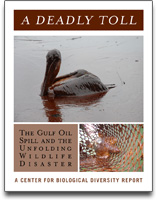 The Center for Biological Diversity has released a report tallying impacts of the disaster on the region's birds, sea turtles, dolphins and other wildlife. Titled A Deadly Toll: The Gulf Oil Spill and the Unfolding Wildlife Disaster the report compiles federal data, and scientific papers to estimate the number of animals hurt by the spill so far. The Center estimates approximately 6,000 sea turtles, 26,000 dolphins and whales, 82,000 birds, and countless fish and invertebrates may have been harmed by the disaster.
The Center for Biological Diversity has released a report tallying impacts of the disaster on the region's birds, sea turtles, dolphins and other wildlife. Titled A Deadly Toll: The Gulf Oil Spill and the Unfolding Wildlife Disaster the report compiles federal data, and scientific papers to estimate the number of animals hurt by the spill so far. The Center estimates approximately 6,000 sea turtles, 26,000 dolphins and whales, 82,000 birds, and countless fish and invertebrates may have been harmed by the disaster.Based on the same research sources the Center concludes that ongoing effects of previous oil spills and pollution from the 2010 BP spill will continue to affect Gulf wildlife for decades. The report also shows that US government counts underestimate the toll on biodiversity, especially birds, turtles and sea mammals. Also none of the animals washing ashore spring 2011 are included in government counts. Scientists estimate that at least five times as many turtles die as wash up on shore, indicating that between 5,730 and 6,165 sea turtles have likely been harmed by the spill to date. For marine mammals, scientists estimate that up to 50 times as many are killed as wash ashore. "The BP Deepwater Horizon disaster is a tragic lesson that politicians are refusing to learn. Catastrophic oil spills will continue to threaten our nation's wildlife as long as our country continues to push for more and more offshore drilling," said Tierra Curry, a biologist at the Centre. London based BP ( for British Petroleum) held its annual shareholder's meeting in England April 12, 2011. Protestors both inside and outside the meeting received international media attention regarding: BP's role in Canada's oil sands, Gulf of Mexico economic and community impacts, compensation payments a fraction of submissions, and executive pay awards, among other issues. View April 12, 2011 Center for Biological Diversity press releaseView April 13, 2011 Environmental News Network article View April 12, 2011 Bloomberg article View April 14, 2011 Guardian article View April 14, 2011 The Independent article View April 15, 2011 New Internationalist blog post
Sources: Centre for Biological Diversity, Environmental News Network, Bloomberg.com
|
|
 Print version Print version |
Top |
| Bolivia's 'Mother Earth' Treaty to UN | 16 April 11 |
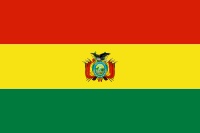 Bolivia will table a draft United Nations treaty giving "Mother Earth" the same rights as humans during April 2011. Bolivia's new Law of Mother Earth redefines the country's rich mineral deposits as "blessings" and is expected to lead to new conservation and social measures to reduce pollution and control industry.
Bolivia will table a draft United Nations treaty giving "Mother Earth" the same rights as humans during April 2011. Bolivia's new Law of Mother Earth redefines the country's rich mineral deposits as "blessings" and is expected to lead to new conservation and social measures to reduce pollution and control industry.The UN treaty aims to have the UN recognize the Earth as a living entity that humans have sought to "dominate and exploit" - to the point that the "well-being and existence of many beings" is now threatened. Bolivia's Law of the Rights of Mother Earth provides the basis for draft language of this new UN treaty. Bolivia's law establishes a Ministry of Mother Earth, and provides the planet with an ombudsman whose job is to hear nature's complaints as voiced by activist and other groups, including the state. Bolivia's ambassador to the UN Pablo Salon stated, ""If you want to have balance, and you think that the only (entities) who have rights are humans or companies, then how can you reach balance? "But if you recognize that nature too has rights, and (if you provide) legal forms to protect and preserve those rights, then you can achieve balance." Council of Canadians leader Maude Barlow is among global environmentalists backing the drive for the UN treaty, with a book she will launch in New York during the UN debate: Nature Has Rights. "It's going to have huge resonance around the world," Barlow said of the campaign. "It's going to start first with these southern countries trying to protect their land and their people from exploitation, but I think it will be grabbed onto by communities in our countries, for example, fighting the tarsands in Alberta." Other South American countries support the Bolivia initiative. Debate at the UN begins April 20, 2011. The World People's Conference on Climate Change and the Rights of Mother Earth, held in Bolivia, April 2010, proposed a Universal Declaration of the Rights of Mother Earth. View April 13, 2011 Vancouver Sun articleView April 12, 2011 Daily Mail article View April 12, 2011 Yahoo! News article View April 27, 2010 early draft of possible language for UN Treaty View World People's Conference on Climate Change and the Rights of Mother Earth - Conference web site View April 13, 2011 Huffington Post article
Sources: Common Dreams, MotherEarthRights.org, United Nations, News Day
|
|
 Print version Print version |
Top |
| TransCanada Keystone KL Pipeline - US EIS Released | 16 April 11 |
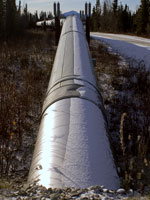 The US State department is under pressure to delay any approval of the TransCanada pipeline from Alberta to Texas. Citizens across several US states are objecting to 'eminent' domain' disruption of their lands for the pipeline, which is a taking up similar to expropriation in Canada. The first environmental impact statement (EIS) for the pipeline in the US was rejected by citizen groups, members of Congress. The US Environmental Protection Agency gave the initial environmental statements its worst rating. The US State department indicated it would solve the deficiencies in the EIS.
The US State department is under pressure to delay any approval of the TransCanada pipeline from Alberta to Texas. Citizens across several US states are objecting to 'eminent' domain' disruption of their lands for the pipeline, which is a taking up similar to expropriation in Canada. The first environmental impact statement (EIS) for the pipeline in the US was rejected by citizen groups, members of Congress. The US Environmental Protection Agency gave the initial environmental statements its worst rating. The US State department indicated it would solve the deficiencies in the EIS.On April 15, 2011 The U.S. State Department released a Supplemental Draft Environmental Impact Statement (SDEIS) for the controversial Keystone XL pipeline, which would carry polluting oil from Canada across six U.S. states to refineries in Texas. Friends of the Earth US campaigner Alex Moore said, "The American public is still not getting a complete picture of the many serious dangers that this mega-pipeline would pose. On first reading, we are concerned that the State Department has still not done a serious and thorough analysis of significant dangers, including the safety of tar sands oil pipelines and the pollution caused by tar sands oil production." The draft EIS does acknowledge that oil from Alberta has far more greenhouse gas emissions. The usual period for public comments has been shortened, and no public hearings are included in the review, at this time. Thirty two groups wrote Secretary of State Hilary Clinton a letter in early April with expectations of thorough public comments period and public hearings. The pipeline involves approximately 1,711 miles of new, 36-inch-diameter pipeline, with approximately 327 miles of the pipeline in Canada, and a transport capacity of 900,000 barrels per day (bpd) of crude oil. Because the pipeline would cross the Canada-US border it requires a presidential permit, and disclosure of environmental risks and impacts. View The Supplemental Draft Environmental Impact Statement for the Keystone XL pipeline (PDF)View April 4, 2011 Letter to Secretary Clinton regarding comment period and hearings (PDF) View April 15, 2011 Friends of the Earth US press release View April 12, 2011 Dirty Oil Sands article View Dirty Oil Sands website Sources: US State Department, Friends of the Earth US, Common Dreams, Wall Street Journal |
|
 Print version Print version |
Top |
| Taseko Tries Fish Lake Again: Credit Suisse at Risk | 9 April 11 |
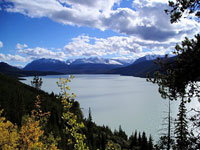 A revised application for the rejected Prosperity Mine still calls for the destruction of one of the two fish-bearing mountain lakes originally scheduled for eradication.
A revised application for the rejected Prosperity Mine still calls for the destruction of one of the two fish-bearing mountain lakes originally scheduled for eradication."It is unlikely that Fish Lake would be saved under the new plan, given there would be a massive tailings impoundment immediately upstream and the lake would be in the centre of an industrial mining site," said Ramsay Hart of Mining Watch Canada. B.C. rookie Premier, Christy Clark, has said one of her top priorities is to reverse Ottawa's decision to reject the proposed gold and copper mine. Prime Minister Stephen Harper said the review of the original decision is final, but Environment Minsiter Peter Kent has "...invited the proponent to redesign the project." In response to the revamped proposal, First Nations and environmentalists are urging Taseko Mines Ltd financial backer Credit Suisse to reject funding for the open-pit Prosperity Mine, which would threaten Little Fish Lake and the traditional way of life of the Tsilhqot'in people. The letter to Credit Suisse notes that, despite spending 17 years and an estimated $100 million pursuing the project, Taseko Mines Ltd. has failed to secure "the free, prior and informed consent of the affected community." Both the rejected proposal and recent revision were developed "without any consultation with the potentially impacted First Nation communities." "We are not against mining per se, but projects like this one can never be accepted, and pursuing them only waste everyone's time and resources. We are not willing to sell out the land, the water and our rights, future generations and way of life at any price," said Xeni Gwet'in Chief Marilyn Baptiste, whose Tsilhqot'in First Nation would be most directly impacted. View March 7, 2011 Mining Watch Canada / Earthworks releaseView March 2, 2011 Letter to Credit Suisse (PDF) View February 22, 2011 West Coast Environmental Law blog View February 22, 2011 Government of Canada statement (PDF) View Sierra Club of B.C. webpage "Fish Lake Mine Proposal Revisited" View April 7, 2010, July 19, 2010, and November 9, 2010 Manitoba Wildlands news items Source: Sierra Club, Mining Watch Canada |
|
 Print version Print version |
Top |
| Responses to Manitoba Cap and Trade Review | 9 April 11 |
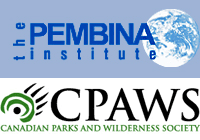 The Pembina Institute submitted comments on Manitoba's proposed cap-and-trade system as required by the Western Climate Initiative (WCI).
The Pembina Institute submitted comments on Manitoba's proposed cap-and-trade system as required by the Western Climate Initiative (WCI).Cap-and-trade is a market-based way to cut greenhouse gases that uses economic incentives so that industrial polluters meet emissions reduction targets. Polluters get emission allowances equal to a government cap. If a plant's pollution exceeds the target or cap, it must purchase emission allowances from facilities that have reduced more than their share or else pay fines. The Pembina Institute suggested: Manitoba move quickly to implement a cap-and-trade system by January 2012, set a cap that aligns with short- and medium-term emissions reduction targets, include all source of measurable emissions, and distribute allowances by auction, and eliminate or reduce any reliance on offsets. Canadian Parks and Wilderness Society (CPAWS) Manitoba Chapter submitted comments that echo Pembina Institutes concerns, warning about the short-comings of relying on offsets, and arguing that revenue from a carbon pricing scheme should be used to fund GHG reductions, such as investing in carbon storage through ecosystem protection. The Manitoba Government set up a webpage to collect comments on the proposed Cap and Trade system; however the comments are not being made publicly available on the Government webpage. There is also no public registry for the review. View March 15, 2011 Pembina Institute "Recommendations for Manitoba's proposed cap-and-trade system"View March 16, 2011 CPAWS Manitoba Chapter "Recommendations for Manitoba's proposed cap-and-trade system" View Manitoba Government "Cap and Trade Consultation" webpage View December 4, 2011 Manitoba Wildlands news item Source: Pembina Institute |
|
 Print version Print version |
Top |
| Keystone XL Pipeline Controversy Continues | 9 April 11 |
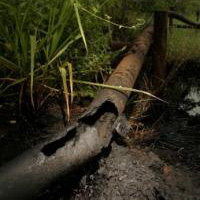 A New York Times editorial, published April 2nd, 2011, urging US secretary of State Hillary Clinton not to permit the Keystone XL pipeline has reinvigorated the debate surrounding the pipeline.
A New York Times editorial, published April 2nd, 2011, urging US secretary of State Hillary Clinton not to permit the Keystone XL pipeline has reinvigorated the debate surrounding the pipeline.The 2,735km (1,700-mile) oil TransCanada pipeline would link the oils sands fields of northern Alberta to Texas refineries and aims to begin operating in 2013. The environmental risks include: strip-mining huge chunks of Alberta's boreal forest, using vast quantities of water and energy, creating 82 percent more emission than those from conventional crude oil, toxic holding ponds that kill migrating birds and pollute downstream watersheds, increased risks of pipeline leaks oil sands oil in a pipeline is more corrosive than crude oil, disruption of the porous sandy soils of the Montana and the Nebraska Sand Hills, and risks to the Ogallala Aquifer, which provides drinking water for two million people. The US Environmental Protection Agency gave the State Departments draft environmental impact statement for the Keystone XL pipeline its lowest possible ranking: "inadequate" July 2010. Deficiencies cited included lack of accounting for greenhouse gas emissions, safety and spill-response planning concerns, and inattentiveness to potential impact on Canadas indigenous communities. That criticism prompted preparation of whats known as a supplemental environmental impact statement on Keystone XL, expected spring 2011. A coalition of 32 groups sent a letter to Secretary of State Hillary Clinton early in April asking her to extend the usual public comment period from 45 to 120 days and to organize on-the-ground public hearings in Montana, South Dakota, Nebraska, Kansas, Oklahoma and Texas. Eleven US Senators, and fifty Members of the US House of Representatives have publicly opposed the Keystone XL. On April 6, 2011 President Barack Obama said concerns about the potentially "destructive" nature of the Canadian "tar sands" need to be answered before his administration decides whether to approve the construction of Calgary-based TransCanada's controversial Keystone XL pipeline. View April 4, 2011 Canadian Press articleView April 3, 2011 Montreal Gazette article View April 2, 2011 New York Times editorial View April 1, 2011 Reuters article View February 12, 2011, November 3, 2010, and August 4, 2010 Manitoba Wildlands news items View October 29, 2010 Letter from US Senators to Hilary Clinton (PDF) View June 23, 2010 Letter from US Representatives to Hilary Clinton (PDF) Source: New York Times, National Post, Solve Climate News |
|
 Print version Print version |
Top |
| Harper Endorses Churchill River Project | 2 April 11 |
 One week into Canada's national election campaign, Prime Minister Stephen Harper announced a re-elected Conservative government will consider financial support for major clean energy infrastructure projects that have regional or national significance. In doing so he identified the Lower Churchill River Project in Labrador, at the eastern side of Canada, as the first significant 'clean energy' project.
One week into Canada's national election campaign, Prime Minister Stephen Harper announced a re-elected Conservative government will consider financial support for major clean energy infrastructure projects that have regional or national significance. In doing so he identified the Lower Churchill River Project in Labrador, at the eastern side of Canada, as the first significant 'clean energy' project.He said his Government will provide a loan guarantee or other financial support for the Lower Churchill hydro-electric project. The project will provide Atlantic Canada with a major new source of clean energy, and is identified as a major regional environmental initiative. The criteria for this new federal government program would be:
Gaile Whelan Enns told Manitoba Wildlands.org: " We hope Mr. Harper knows how many hydro projects are on the drawing board in Manitoba. Perhaps when he stops in Winnipeg during the election he will make a similar announcement. Once there are federal funds in an energy project the environmental licensing responsibilities of our federal government increase. This would mean that environmental effects, cumulative impact statements, and monitoring for both construction and operation would all see increased federal oversight." View March 31, 2011 Conservative Party of Canada news release and backgrounderView Newfoundland and Labrador government information page View April 1, 2011 CBC News article View March 31, 2011 Globe and Mail article Source: CBC, Globe and Mail, Conservative Party of Canada |
|
 Print version Print version |
Top |
| Clean Energy Success - Election 2011 Checklist | 2 April 11 |
 The Pembina Institute has released a checklist for Canada's federal election - and for clean energy success. Throughout the Canada federal election campaign, the Pembina Institute will be assessing parties' climate change and energy commitments using the checklist criteria which are drawn from its research and analysis on these topics.
The Pembina Institute has released a checklist for Canada's federal election - and for clean energy success. Throughout the Canada federal election campaign, the Pembina Institute will be assessing parties' climate change and energy commitments using the checklist criteria which are drawn from its research and analysis on these topics.Pembina Institute, an energy and environment think tank in Alberta and member of Climate Action Network Canada, works for a long-term transition from the current reality - dominated by high impact, inefficient, non-renewable, carbon intensive energy systems - to a sustainable future that utilizes 100% low-impact, renewable energy. Pembina works on four key policy areas, so our checklist covers all of them: climate change, oilsands, renewable energy and efficiency, and sustainable transportation. "At a time when climate scientists tell us we need global emissions to peak and start declining within a handful of years, Canada isn't close to being on track to hit its current 2020 greenhouse gas target. The winner of this election gets to set the direction of Canada's energy and climate policy at a crucial moment", states Ed Whittingham, in his Pembina blog about the check list. View April 1, 2011 Pembina Institute reportView Ed Whittingham Pembina Institute blog: Campaigning for the climate and clean energy Source: Pembina Institute |
|
 Print version Print version |
Top |
| Great Bear Rainforest Protection | 2 April 11 |
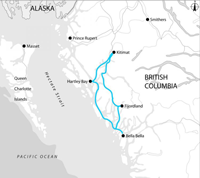 The new Premier of British Columbia, Christy Clark, is being challenged to act on the 2009 agreements signed by her government to protect the coastal Great Bear Rainforest. The 2009 agreement with First nations, environmental groups and logging companies aimed to protect the rain forest, increase First Nations role in decisions, and support sustainable economic practices. The letter to the Premier from Canadian and international environmental organizations, sent on the second anniversary of the signing of the Great Bear Forest Agreements, serves as a reminder to the new premier that she needs to fulfill the agreements, rapidly.
The new Premier of British Columbia, Christy Clark, is being challenged to act on the 2009 agreements signed by her government to protect the coastal Great Bear Rainforest. The 2009 agreement with First nations, environmental groups and logging companies aimed to protect the rain forest, increase First Nations role in decisions, and support sustainable economic practices. The letter to the Premier from Canadian and international environmental organizations, sent on the second anniversary of the signing of the Great Bear Forest Agreements, serves as a reminder to the new premier that she needs to fulfill the agreements, rapidly.The ancient Great Bear Rainforest is one of the largest contiguous tracts of temperate rainforest left in the world. It is also home to the Spirit Bears. The Great Bear Rainforest stretches along the BC coast starting opposite the north end of Vancouver Island all the way to Alaska, and covers 2 million hectares. Sierra Club, Greenpeace, and Forest Ethics work together for the protection of the Great Bear Rainforest. "It's the largest, mostly intact temperate rain forest on the planet and it's both a global ecological treasure and ... a remarkable story of collaboration," said Jen Wieting of Sierra Club BC. "We have a unique responsibility in this part of the world to follow through and implement this model." View Sierra Club BC April 1, 2011 press releaseView Globe and Mail April 1, 2011 article Send letters to BC Premier and Minister about protection for the Great Bear Rain Forest View Rain Forest Solutions Project website Source: Globe and Mail, Sierra Club BC |
|
 Print version Print version |
Top |
| South Saskatchewan River Delta - No Action Yet | 26 March 11 |
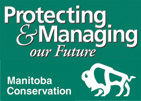 Manitoba Conservation put this proposed protected area to public review mid 2010, with public comments closing in October 2010. Although based on Areas of Special Interest from several years ago designed by Manitoba Conservation, with Mineral Sector reviews at the time, information about the proposed protected area is sparse. Mapping provided on the department's web pages provides no indication of Areas of Special Interest involved, the natural region location, or landscape types to be included. The area includes Red Deer Lake, along the Saskatchewan border, south of The Pas.
Manitoba Conservation put this proposed protected area to public review mid 2010, with public comments closing in October 2010. Although based on Areas of Special Interest from several years ago designed by Manitoba Conservation, with Mineral Sector reviews at the time, information about the proposed protected area is sparse. Mapping provided on the department's web pages provides no indication of Areas of Special Interest involved, the natural region location, or landscape types to be included. The area includes Red Deer Lake, along the Saskatchewan border, south of The Pas.Requests from Manitoba Wildlands for technical information and improved mapping for this proposed protected area have gone unanswered. Important Bird Areas review has occurred, and the altered ecosystem provides nesting and habitat for many bird species. Overtime land species, large mammals, and ungulates have returned to the area. "Manitoba Wildlands expects clarity on the status of this proposed protected area. In the meantime changes in boundary, and alterations to the plan for the area may be occurring. Priorities set for protected areas decisions 4 years ago include the South Saskatchewan River Delta," stated Gaile Whelan Enns. View Manitoba Conservation public review page for South Saskatchewan River DeltaView Kelsey Municipality Mitigation Reserve Fund Bill View Manitoba Wildlands web page for protected areas reviews Source: Manitoba Conservation |
|
 Print version Print version |
Top |


 RSS Feeds:
RSS Feeds: